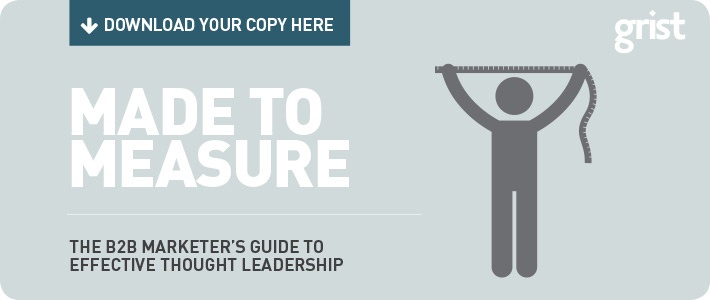As a B2B marketer, thought leadership surveys are one of the most powerful options in your toolkit. A carefully planned and executed survey can help you generate new insight, gain exposure for your brand and support business development.
In the first of our series of blogs about B2B surveys, we examined their benefits, and looked at why cost needn’t be a barrier to carrying out surveys. Here we explore the four main B2B survey options you’ll want to consider.
Global flagship research
This is the big one: large-scale international outreach to senior business decision-makers across several markets and sectors. Participants generally number at least 500, and potentially go up to several thousand, allowing credible comparative analysis and insights across sectors, geographic areas, organisation types, and so on.
The survey may be supplemented with more in-depth senior executive interviews, to produce deeper insight into the issues at hand.
Global research of this kind is often carried out by high-profile B2B brands, particularly in the technology and professional services spaces. Many use it to create a regular ‘barometer’ of their market.
Topics tend to focus on the major external issues facing the brand’s target audience. The idea is to ‘own’ a subject area that is aligned with your offering, and important to your clients. Good examples of this approach include CA Technologies’ Digital Transformation research programme and the annual Capgemini World Quality Report.
Market or sector research
This is effectively a smaller – and therefore less costly – version of the global flagship survey, covering a single national market or sector.
It generally consists of 20 closed questions to 100 or so respondents, and may or may not include additional in-depth interviews.
Like flagship research, it may form the basis of a regular barometer – part of an ongoing campaign to help you own a key strategic theme. But it can also be used to create a one-off ‘splash’ highlighting a particular business issue that the business can help resolve.
The research undertaken by executive search and interim management firm Intramezzo, exploring the major talent challenges faced by corporate and venture capital / private equity portfolio companies is a good example of this focused approach.
Benchmarking tools
Benchmarking surveys are the most directly sales-led form of research. They’re used mostly to support business development and inform sales conversations.
They’re designed to build a database of information that will enable you to benchmark an organisation’s performance in an area that your service offering can improve. The aim is to allow clients and prospects to see how they measure up compared to their peers.
Benchmarking tools usually focus on internal, operational matters, to expose the sort of problems that you help solve. This creates a ‘fear factor’ to persuade customers to buy your solutions. Allowing clients and prospects to see where they’re not cutting it gives your salespeople a compelling pitch.
This list of sales leads is about as hot as it gets. They have demonstrated engagement by completing the survey, you can develop genuine client-specific insight when comparing their data with their peers and very few turn down the chance to learn how they stack up against competitors and can improve performance. These campaigns typically enjoy 80% take-up.
Barnett Waddingham have used this approach with their Risk maturity benchmarking programme.
Express surveys
Affectionately known as the ‘quick and dirty’ option, express surveys do what they say on the tin. They’re fast-turnaround opinion polls, usually completed in a matter of days.
This is short, sharp research, typically aimed at a single audience, and a single issue or development. It comprises a very limited number of closed questions to a focused respondent group.
Though restricted in themes and numbers, express surveys are extremely versatile, as they have a wide range of potential applications. They can be used to rapidly generate data that will help inform:
- a response to an opportunity or threat from an unexpected industry development
- a defence in the face of sudden reputational damage
- a counter-strike to a competitor’s marketing tactics
- useful intelligence when tendering for work, in order to demonstrate market expertise (‘bid polls’)
- understanding of market sentiment on a particular issue – as a one-off, or on a regular basis (‘pulse surveys’).
The Hampshire Trust Bank, for example, does an annual survey of SME savings patterns, which garnered coverage across a range of trade and business press in late 2016, including City AM, Business Matters and The Law Society Gazette.
Making the right choice
So how do you know which survey option will best support your marketing campaign?
Each approach has its advantages and drawbacks. Designed correctly, large global surveys should generate more headlines, and have more potential applications in terms of content marketing over a longer period. But on the downside, they’re costlier. They’re also less agile, as they take time to plan and deliver.
At the other end of the scale, express surveys are cost-effective, highly targeted, and can enable a nimble response to an emerging need. However, their shelf-life will be shorter, and they’ll generate far less depth of data.
Which option you should use will depend on several factors: budgets, timescales and – most importantly – your objectives. What do you need your survey to achieve? What sort of activity will it inform? What content pieces do you plan to generate off the back of it?
More to come…
At Grist, we’ve helped many B2B brands to realise the power of surveys as a content marketing tool – and also as a source of competitive intelligence. This blog has looked at what survey formats you should explore; a previous blog looked at why B2B surveys are so effective and upcoming blogs will show how you can ensure they are successful and run through the plethora of assets you can create to engage clients and prospects at all stages of the BD pipeline.
In the meantime, please get in touch if you’d like to discuss how a survey could help make your campaigns more effective.



